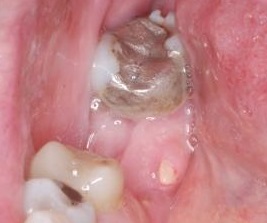Medication-related osteonecrosis of the jaw
Editor-In-Chief: Prab R Tumpati, MD
Obesity, Sleep & Internal medicine
Founder, WikiMD Wellnesspedia &
W8MD medical weight loss NYC and sleep center NYC
| Medication-related osteonecrosis of the jaw | |
|---|---|
| Synonyms | MRONJ |
| Pronounce | N/A |
| Specialty | N/A |
| Symptoms | Exposed bone in the mouth, pain, swelling, infection |
| Complications | Pathologic fracture, osteomyelitis, oral fistula |
| Onset | After dental surgery or spontaneously |
| Duration | Long-term |
| Types | N/A |
| Causes | Bisphosphonates, denosumab, antiangiogenic drugs |
| Risks | Cancer, osteoporosis, Paget's disease of bone |
| Diagnosis | Clinical examination, imaging studies |
| Differential diagnosis | Osteoradionecrosis, osteomyelitis, periodontal disease |
| Prevention | Dental examination before starting medication, good oral hygiene |
| Treatment | Antibiotics, oral rinses, surgical debridement |
| Medication | N/A |
| Prognosis | Variable, can be chronic |
| Frequency | Rare |
| Deaths | N/A |
Medication-related osteonecrosis of the jaw (MRONJ) is a serious condition involving the bone of the jaw, characterized by the presence of exposed bone in the mouth that does not heal within eight weeks in a patient who has been taking certain medication and has not received radiation therapy to the craniofacial region. MRONJ is associated with the use of bisphosphonates, a class of drugs used to treat osteoporosis and metastatic bone disease, among other conditions. However, other medications, such as denosumab and anti-angiogenic drugs, have also been implicated in the development of this condition.
Etiology and Pathophysiology
The exact mechanism by which these medications cause osteonecrosis of the jaw is not fully understood. It is believed that bisphosphonates, which have a high affinity for bone tissue, may impair bone remodeling by inhibiting osteoclast activity, leading to an accumulation of micro-damages and eventually bone necrosis. Denosumab, a monoclonal antibody that inhibits RANKL (Receptor Activator of Nuclear Factor κB Ligand), plays a crucial role in the regulation of osteoclasts and can similarly impair bone remodeling and repair.
Risk Factors
Several factors increase the risk of developing MRONJ, including:
- Duration and route of medication administration, with higher risk associated with intravenous administration and longer treatment duration.
- Dental procedures, such as tooth extractions, which can act as a local trigger.
- Poor oral hygiene and pre-existing dental disease.
- Use of corticosteroids and immunosuppressive therapy, which may compound the risk.
Clinical Presentation
Patients with MRONJ may present with pain, swelling, and infection of the soft tissues around the exposed bone. The exposed bone is usually visible in the mouth, but asymptomatic cases are also reported. Symptoms can range from mild discomfort to severe pain and can significantly impact the patient's quality of life.
Diagnosis
Diagnosis of MRONJ is primarily clinical, based on the history of medication use and the presence of exposed bone in the jaw that does not heal within eight weeks. Imaging studies, such as panoramic radiographs or CT scans, can be helpful in assessing the extent of bone involvement.
Management
The management of MRONJ focuses on reducing pain, controlling infection, and minimizing the progression of bone necrosis. Treatment strategies include:
- Conservative measures, such as oral rinses and antibiotics, for early-stage disease.
- Surgical debridement or resection for more advanced cases or when conservative treatment fails.
- Cessation or modification of the causative medication, in consultation with the prescribing physician, may be considered in some cases.
Prevention
Preventive measures are crucial and include thorough dental evaluation and treatment of any oral disease before initiating therapy with high-risk medications. Patients on these medications should maintain excellent oral hygiene and avoid invasive dental procedures whenever possible.
Summary
Medication-related osteonecrosis of the jaw is a challenging condition that requires a multidisciplinary approach for management and prevention. Awareness among healthcare providers and patients about the risk factors and early signs of MRONJ is essential for early diagnosis and effective treatment.
Additional images
Transform your life with W8MD's budget GLP-1 injections from $125.
W8MD offers a medical weight loss program to lose weight in Philadelphia. Our physician-supervised medical weight loss provides:
- Most insurances accepted or discounted self-pay rates. We will obtain insurance prior authorizations if needed.
- Generic GLP1 weight loss injections from $125 for the starting dose.
- Also offer prescription weight loss medications including Phentermine, Qsymia, Diethylpropion, Contrave etc.
NYC weight loss doctor appointments
Start your NYC weight loss journey today at our NYC medical weight loss and Philadelphia medical weight loss clinics.
- Call 718-946-5500 to lose weight in NYC or for medical weight loss in Philadelphia 215-676-2334.
- Tags:NYC medical weight loss, Philadelphia lose weight Zepbound NYC, Budget GLP1 weight loss injections, Wegovy Philadelphia, Wegovy NYC, Philadelphia medical weight loss, Brookly weight loss and Wegovy NYC
|
WikiMD's Wellness Encyclopedia |
| Let Food Be Thy Medicine Medicine Thy Food - Hippocrates |
Medical Disclaimer: WikiMD is not a substitute for professional medical advice. The information on WikiMD is provided as an information resource only, may be incorrect, outdated or misleading, and is not to be used or relied on for any diagnostic or treatment purposes. Please consult your health care provider before making any healthcare decisions or for guidance about a specific medical condition. WikiMD expressly disclaims responsibility, and shall have no liability, for any damages, loss, injury, or liability whatsoever suffered as a result of your reliance on the information contained in this site. By visiting this site you agree to the foregoing terms and conditions, which may from time to time be changed or supplemented by WikiMD. If you do not agree to the foregoing terms and conditions, you should not enter or use this site. See full disclaimer.
Credits:Most images are courtesy of Wikimedia commons, and templates, categories Wikipedia, licensed under CC BY SA or similar.
Contributors: Prab R. Tumpati, MD










